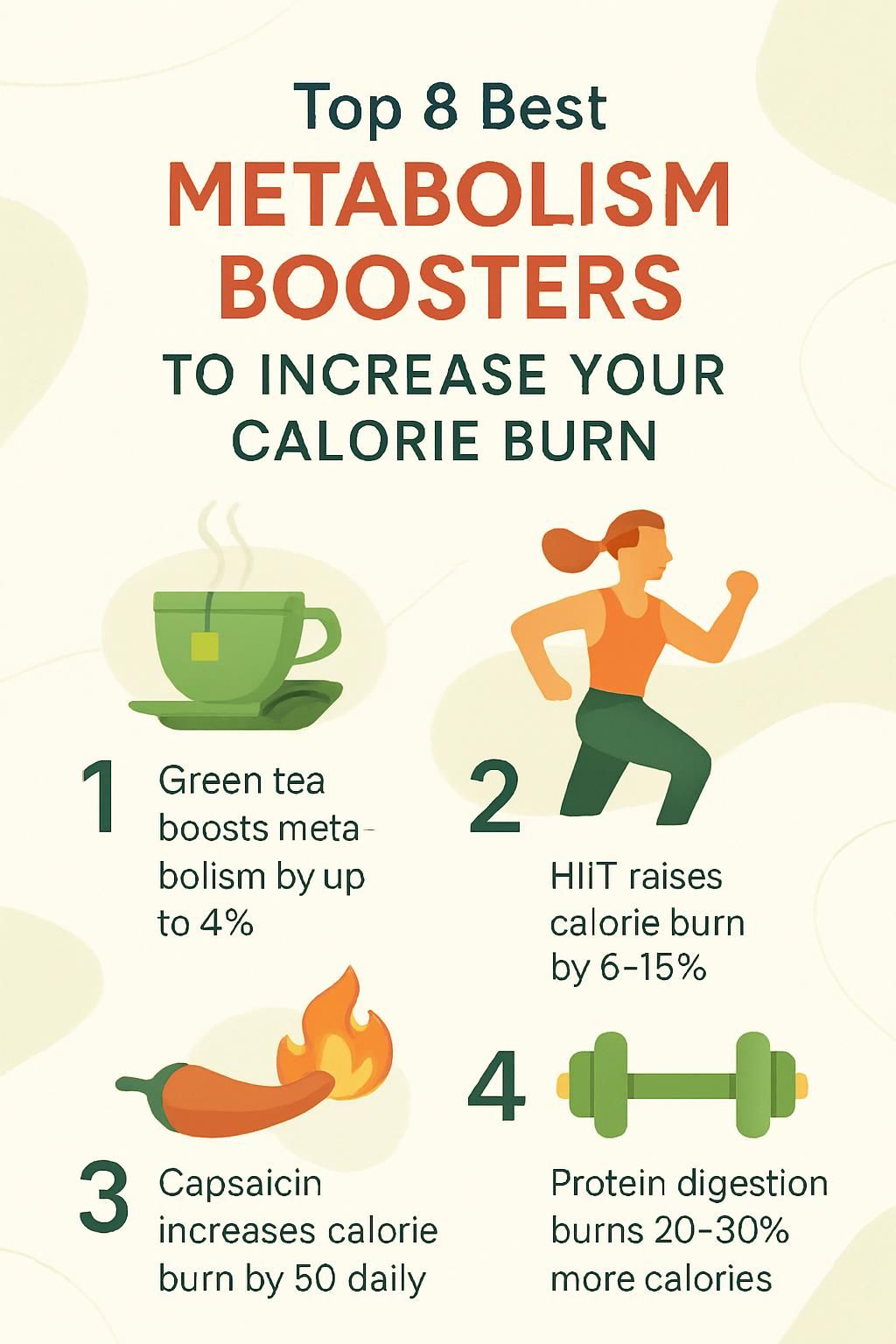Top 8 Best Metabolism Boosters To Increase Your Calorie Burn
Our Nutrition Assistant AI Suite will transform your body. You will lose fat, get toned, and build muscle. Gain confidence and optimal health.
If you find it hard to burn calories or lose weight, you are not alone. Metabolism, the process that turns food into energy, shapes how easily you manage weight and energy.
This guide highlights the best metabolism booster foods and daily habits backed by research. You will get simple steps to boost metabolism naturally and fit them into your routine.
Key Takeaways
- Green tea may boost metabolism by up to 4 percent per day due to EGCG and caffeine, based on clinical trials and reviews.
- HIIT can raise energy expenditure 6 to 15 percent for up to two hours after exercise, according to reviews from 2020 and 2022.
- Capsaicin in chili peppers can add about 50 calories of daily burn through thermogenesis, as shown in controlled studies.
- Protein-rich foods produce the highest thermic effect, about 20 to 30 percent of their calories burned during digestion.
- Drinking water can raise metabolic rate by about 30 percent within ten minutes, according to The Journal of Clinical Endocrinology & Metabolism.

Understanding Metabolism

Metabolism is the set of chemical reactions that turn food and drinks into energy. Your metabolic rate is the number of calories you burn each day to stay alive and active.
What is metabolism and how does it work?
Your body uses metabolism to power breathing, circulation, movement, growth, and thinking. Basal metabolic rate, or BMR, is the calories your body needs at rest for basic functions like heartbeat and blood flow.
About 60 to 75 percent of the calories you burn each day come from your BMR. Eating, daily movement, and workouts add more on top of that. Building muscle can raise BMR because muscle cells use more energy than fat cells, even when you sit or sleep.
The speed at which you burn fuel changes with muscle mass, activity level, and habits.
How does metabolism affect calorie burning?
Metabolism controls how your body converts food energy into fuel. A higher resting metabolic rate means you burn more calories, even while sitting or sleeping.
Total energy expenditure has three parts: basal metabolic rate, non-exercise activity like walking or chores, and planned exercise like strength training or intervals. More skeletal muscle often equals a faster metabolism and higher daily calorie burn.
Hormones and blood sugar also matter. Protein-rich meals or green tea can slightly boost calorie burn during digestion. This effect, called the thermic effect of food, helps your plan for weight management.
Factors That Influence Metabolism
Your metabolism responds to many factors. Some, like age and genetics, are fixed. Others, like muscle mass, activity, diet, and hydration, are within your control.
How do age and genetics impact metabolism?
Your genes help set your baseline metabolic rate. Some people naturally burn more calories than others, even at rest. Men often have higher BMR than women because they usually carry more muscle, which uses more energy.
Metabolism tends to slow with age. After about age 20, BMR may drop around 2 percent per decade, mainly due to muscle loss if you do not stay active. People with greater height or higher body mass burn more calories to support basic functions.
Why do muscle mass and physical activity matter?
Muscle is metabolically active tissue. It burns more energy at rest than fat does. Strength training builds muscle, which raises your daily burn, even on rest days.
Exercise also increases calories burned after your workout through EPOC, which stands for excess post-exercise oxygen consumption. High-intensity interval training, or HIIT, can keep your metabolic rate elevated for hours as your body recovers.
Muscle mass is a key driver of BMR alongside genetics. Regular activity, such as lifting, running, or bodyweight exercises, increases energy expenditure and supports blood sugar balance.
How do diet and hydration influence metabolism?
Balanced eating supports a healthy metabolism. Very low calorie diets can slow your burn because the body shifts into energy-saving mode. Aim for enough protein to support lean tissue growth and repair.
Protein has a higher thermic effect than carbohydrates or fats. You burn more calories digesting it. Drinking enough water can also raise daily energy use for a short period, and it helps control appetite.
A simple target is at least half your body weight in ounces of water each day. Cold water may add a small boost because your body warms it to core temperature.
Top 8 Best Metabolism Boosters
Several foods and habits can help increase your metabolism. Each offers a small push. Together, they add up.
- Green tea, rich in EGCG and caffeine, can raise daily calorie burn a few percent.
- Chili peppers with capsaicin trigger heat production, which increases energy use after meals.
- Lean proteins, such as poultry, fish, eggs, and legumes, raise the thermic effect of food and help maintain muscle.
- Whole grains and oatmeal provide fiber for steady blood sugar and longer fullness.
- Coffee supplies caffeine, which increases energy expenditure for a short time.
- Berries offer antioxidants that support cell health and may aid metabolic processes.
- Water supports every metabolic reaction and may increase calorie burn briefly after drinking.
- Legumes, including beans and lentils, deliver protein and fiber that keep you full and active.
Small changes, such as adding protein to breakfast or swapping white rice for beans, can support long-term weight management.
Green Tea
Green tea offers a gentle way to boost metabolism without adding many calories.
What are the metabolism benefits of green tea?
Each 8 ounce cup has about 25 milligrams of caffeine, which helps you burn energy. Three cups a day could add roughly 100 calories of daily burn for some people. Evidence is mixed, so results vary from person to person.
Green tea can fit your diet and exercise plan as a low calorie beverage. It may support weight maintenance and a healthy body mass index when combined with active living.
How do compounds like EGCG boost metabolism?
EGCG, short for epigallocatechin gallate, is a catechin found in green tea leaves. EGCG works with caffeine to promote thermogenesis, which is heat production from calorie burning.
Studies suggest 250 to 300 milligrams of catechins per day can increase daily burn by up to 4 percent. EGCG may also influence hormones like ghrelin and leptin, which affect appetite and fat storage.
During moderate exercise, catechins and caffeine may improve fat use for fuel. If you already enjoy coffee or tea, adding green tea can offer added metabolism support.
Chili Peppers
Spicy foods can warm you up, and that heat can increase energy use for a short time.
What is capsaicin and how does it cause thermogenesis?
Capsaicin is the natural compound that makes peppers like jalapeños taste hot. It can trigger thermogenesis, which causes your body to burn extra calories to create heat.
Research shows capsaicin may increase daily calorie burn by about 50 calories. It acts on cell receptors involved in fat breakdown. Many dietitians suggest adding peppers to balanced meals for a gentle boost.
How do spicy foods increase calorie burn?
Spicy foods raise body temperature for a short period. Your body then uses energy to cool down. This is diet induced thermogenesis, and it adds a small increase in daily burn.
Supplements with concentrated capsaicin may have a larger effect than adding hot sauce. Still, the extra calorie burn from spicy foods remains modest compared with muscle building and regular exercise.
Lean Proteins
Protein helps you burn more during digestion and supports muscle, which boosts resting metabolic rate.
What is the thermic effect of protein-rich foods?
The thermic effect of food, or TEF, is the energy your body uses to digest and process what you eat. Protein has the highest TEF. About 20 to 30 percent of protein calories are used during digestion, compared with 5 to 10 percent for carbs and 0 to 3 percent for fats.
For example, a 200 calorie serving of grilled chicken may cost 40 to 60 calories to digest. Including protein at each meal can support metabolism and more stable blood sugar.
What are good sources of lean protein?
Choose skinless chicken breast, turkey, and fish. Include fatty fish like salmon or sardines twice a week for omega 3 fats and vitamin D. Low fat cottage cheese or Greek yogurt provides calcium with protein.
Plant options such as edamame, beans, and lentils offer protein and fiber. Trim visible fat from meat, and prefer grilling, baking, or roasting over frying. Nuts and chia seeds can add protein, but keep portions small since they are calorie dense.
Whole Grains and Oatmeal
Unrefined grains act like slow burning fuel that steadies your energy and appetite.
How do unrefined carbs affect metabolism?
Unrefined carbohydrates, such as whole grain bread and brown rice, digest slowly because of fiber. This helps prevent blood sugar spikes and keeps insulin resistance lower, which supports healthy calorie burning.
Diet induced thermogenesis tends to be higher in the morning. A larger breakfast built with whole grains can increase burn across the day. People who choose whole grains often do better with weight control than those who rely on refined grains.
What are the benefits of fiber-rich foods?
Oatmeal, vegetables, fruits, and legumes provide dietary fiber that keeps you full longer. Fiber slows the release of sugar into your blood, which supports steady energy and less snacking.
Regular fiber intake supports digestion and may reduce risk for type 2 diabetes. Many people find that fiber helps them manage calorie intake and maintain a healthy weight.
Coffee
Coffee can help increase energy expenditure for a short period and support alertness for workouts.
How does caffeine impact energy expenditure?
Caffeine raises basal metabolic rate and thermogenesis, so you burn more calories at rest for a short window. An 8 ounce cup has about 95 milligrams of caffeine. Many supplements provide about 200 milligrams per serving.
Over time, your body adapts, so the effect may fade with heavy daily intake. Moderate use can support energy for exercise without jittery feelings.
What are the best ways to consume coffee for metabolism?
Choose black coffee or add a small splash of low fat milk. This keeps calories low, which protects the benefits. Moderate intake, about one to two cups per day, can increase metabolic rate slightly and support focus.
Avoid sugary syrups and whipped toppings that add many calories. Spread cups across the morning to help energy levels and protect sleep. If you have high blood pressure, bone concerns, or mineral imbalances, talk with a doctor before changing your caffeine routine.
Berries
Berries are small, nutrient dense fruits that support cell health and energy production.
How do antioxidants support metabolism?
Antioxidants protect cells from free radical damage, which can hinder metabolic processes. Lower inflammation supports healthy metabolism and better nutrient use.
Research in peer reviewed journals links antioxidant rich diets to better metabolic health. Berries also supply vitamins and minerals needed for energy inside each cell.
What are the nutritional benefits of berries?
Berries such as blueberries and strawberries provide fiber with few calories. One cup of blueberries has about 4 grams of fiber and only 84 calories, which helps with fullness and blood sugar control.
They are rich in vitamin C, vitamin K, and manganese. Fresh or unsweetened frozen berries work well in oatmeal, yogurt, and salads.
Water
Water supports every metabolic reaction, so regular hydration is one of the simplest ways to help your body burn energy.
Why is hydration important for calorie burn?
Your body needs water for energy production in cells. A study in The Journal of Clinical Endocrinology & Metabolism found that drinking about 17 ounces, or 500 milliliters, of water raised metabolic rate by roughly 30 percent within ten minutes.
Hydration also supports appetite control. A common target is to drink in ounces at least half your body weight in pounds. Staying hydrated helps your muscles work better during exercise, which supports a healthy metabolic rate.
How does cold water have a thermogenic effect?
Cold water slightly increases calorie burn because your body warms the fluid to core temperature. Drinking 500 milliliters of cold water may use about 12 calories during this warming process.
The effect is small, but it can add up when you drink water consistently through the day. Pair hydration with enough sleep, protein, and regular activity for the best results.
Legumes (Beans and Lentils)
Legumes are budget friendly foods that combine protein and fiber to support sustained energy and fullness.
How do high protein and fiber content in legumes help?
Beans and lentils increase the thermic effect because protein costs more energy to digest. Fiber slows digestion, which steadies blood sugar and reduces cravings.
A half cup of cooked lentils has about 9 grams of protein and 8 grams of fiber. That mix promotes fullness, helps you eat fewer calories, and keeps your metabolism working during digestion.
How do legumes sustain energy?
Legumes contain complex carbohydrates that break down slowly. This delivers steady glucose to your blood, so you avoid rapid spikes and crashes.
One cup of lentils provides about 35 percent of your daily iron needs. Iron helps move oxygen in your blood, which supports energy through the day. Choose low sodium canned beans for quick, heart smart meals.
Nuts and Seeds
Nuts and seeds supply healthy fats, protein, and fiber that keep you full and support metabolic health.
How do healthy fats support metabolism?
Healthy fats help your body absorb vitamins used in energy production. Almonds, for example, provide fats, fiber, and protein that support fullness and steady blood sugar.
Chia seeds also combine healthy fats, fiber, and protein. They slow digestion, which can help regulate glucose and reduce snacking later in the day.
What are the recommended portion sizes for nuts and seeds?
A standard portion for nuts is one ounce, about 23 almonds or a small handful. Seeds like chia, flax, or sunflower are about two tablespoons per serving.
These foods are energy dense, so portion control matters. One ounce of mixed nuts often provides 160 to 200 calories along with valuable nutrients. Pre portion snacks can help you stay on track.
Lifestyle Changes to Boost Metabolism
Your daily habits can support a higher metabolic rate. Focus on muscle, movement, sleep, and consistency.
How does strength training promote muscle growth?
Strength training challenges muscle fibers. Your body repairs them, and they grow stronger and thicker. More muscle raises basal metabolic rate, which increases calories burned at rest.
Adding one pound of muscle can burn up to 6 extra calories per day compared with a pound of fat [1]. Over months, this steady increase supports long term weight management and metabolic health.
[1] Source: American Council on Exercise.
What are the benefits of high-intensity interval training (HIIT)?
HIIT alternates short bursts of hard work with brief recovery. This method boosts calorie burn during the workout and increases EPOC, the afterburn effect.
Research shows HIIT can raise energy expenditure 6 to 15 percent above resting levels for up to two hours. It trains both your heart and muscles, making it a time efficient strategy for metabolism support.
Vitamins and Minerals That Support Metabolism
Certain vitamins and minerals act as helpers in energy pathways. They turn the food you eat into usable fuel.
How do B vitamins aid energy production?
B vitamins serve as coenzymes, which means they help enzymes do their jobs. Vitamin B1, B2, and B3 help break down carbohydrates for quick energy. Vitamin B6 supports the use of protein during activity.
Without enough B vitamins, cells cannot release energy from carbs, fats, or proteins efficiently. Active people may have higher needs, so a balanced diet rich in B vitamins supports stamina and recovery.
What roles do magnesium and iron play in metabolism?
Magnesium supports muscle and nerve function and helps activate enzymes that break down carbohydrates, fats, and proteins. It also supports ATP production, which is the main energy currency in your cells.
Iron helps red blood cells carry oxygen to your muscles and organs. Adequate iron supports calorie burn during activity. One cup of lentils offers about 35 percent of daily iron needs, which makes it a smart staple for metabolic health.
Do Supplements Work?
Supplement claims vary. Evidence is mixed. Food first, plus training, usually delivers the most reliable changes.
What are popular metabolism-boosting supplements?
Green tea extract combines catechins and caffeine. Studies show small to mixed effects on calorie burn. Capsaicin supplements may add roughly 50 calories of daily burn.
L carnitine helps move fat into cells to be used for energy. A 2020 review found it can reduce weight and BMI, though changes in belly fat are unclear. Doses above three grams per day may cause side effects in some people, especially with kidney issues.
Resveratrol, CLA, and chromium picolinate show limited or inconsistent support in human trials. Results vary, and benefits are usually small.
When should you consider taking supplements?
Consider supplements if you have a diagnosed deficiency, follow a restricted diet, or your clinician advises them. Common needs include vitamin B12 for vegans, iron for anemia, or vitamin D with limited sunlight.
Always talk with your doctor before starting a supplement. Some ingredients can interact with medicines or health conditions. Follow label directions, since high doses can harm rather than help.
Common Myths About Metabolism Boosting
Many tips sound exciting but do not match the evidence. Set clear expectations and focus on habits that work.
What are common metabolism myths debunked?
Very restrictive diets do not boost metabolism. Cutting too many calories can slow your burn as the body conserves energy. Supplements alone rarely cause large changes without solid nutrition and exercise.
Large weight loss does not always raise metabolic rate. In many cases, metabolism drops after weight loss because a smaller body burns fewer calories at rest.
What are realistic expectations for boosting metabolism?
No single food or product will cause huge increases in daily burn. The most reliable path is building muscle, staying active, and eating a balanced diet with enough protein and fiber.
One pound of muscle burns about 6 calories per day at rest, while a pound of fat burns about 2. Genetics and age still matter, so aim for steady progress instead of quick fixes.
Conclusion
You can boost metabolism with small, steady actions. Choose lean proteins, whole grains, berries, legumes, nuts, and seeds. Add green tea or coffee if they suit you. Drink water often, and include chili peppers if you enjoy spice.
Lift weights to build muscle and try short HIIT sessions to raise energy expenditure. These choices support a healthier metabolic rate over time. Talk with your doctor before major changes, especially if you have medical conditions or take medication. With consistency, you will burn more calories and feel more energized.
FAQs
1. What are the top five best metabolism boosters supported by peer-reviewed studies?
Peer-reviewed studies highlight caffeine, green tea extract, protein-rich foods, capsaicin from chili peppers, and resistance training as some of the five best metabolism boosters. Each has shown measurable effects on calorie burn in controlled research.
2. How does dose affect the effectiveness of metabolism boosters?
Dose plays a key role in biochemistry; an effective amount is needed to see results without causing side effects. Peer-reviewed studies often specify optimal doses for each booster to maximize benefits while ensuring safety.
3. Why do experts rely on peer-reviewed studies when recommending metabolism boosters?
Experts use peer-reviewed studies because these sources provide reliable data about how different substances or activities increase calorie burn. This evidence-based approach helps ensure recommendations are safe and effective for most people.
4. Can personal experience support findings from scientific research on metabolism boosters?
Personal experience can illustrate practical application but should not replace evidence from peer-reviewed studies or proper dose guidelines in biochemistry. For example, after adding more protein-rich foods to my meals as suggested by clinical trials, I noticed improved satiety and energy levels during exercise routines.
Summary: The most effective ways to boost your metabolism involve using methods proven by science such as adjusting dose based on biochemistry principles and relying on credible research rather than anecdotal claims alone.







